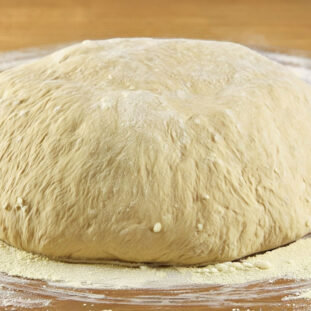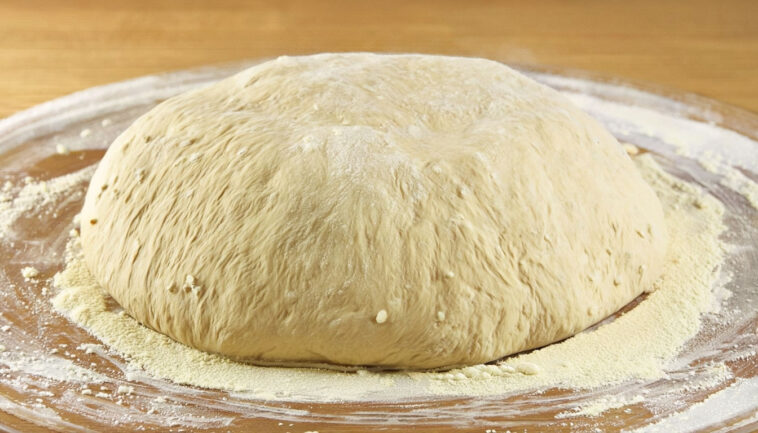The perfect crust makes a perfect pizza. One secret ingredient that can elevate your homemade pizza dough to a whole new level is semolina flour. With its slightly coarse texture and nutritional benefits, semolina flour adds a delightful crispness and a rich, nutty flavor to pizza dough. In this guide, we’ll explore how to make pizza dough recipe with semolina flour, the benefits it offers, and how to create a delicious, healthy pizza the whole family will love.
What is Semolina Flour?
Semolina flour is made from durum wheat, a hard wheat variety that is most commonly used to make pasta. The texture of semolina is more granular than all-purpose flour, which contributes to its unique characteristics when used in baking. Semolina adds a distinct texture and flavor to pizza dough, making it perfect for those who prefer a crispy, slightly chewy crust.
Why Use Semolina Flour for Pizza Dough?
Using semolina flour in pizza dough offers several advantages. It improves the texture by making the crust crispier on the outside while remaining soft and chewy inside. Semolina flour is also higher in protein than regular flour, which helps create a more elastic dough that stretches well without tearing.
Benefits of Using Semolina Flour
- 1. Nutritional Advantages of Semolina
Semolina is rich in essential nutrients like protein, fiber, and B vitamins, which make it a healthier alternative to all-purpose flour. This makes semolina pizza dough a great option for children and adults alike.
- 2. Improved Texture and Crispness
The coarse texture of semolina flour adds an irresistible crunch to the pizza crust. It also makes the dough more elastic, which helps prevent tearing when you stretch the dough, resulting in a chewy, yet crispy crust.
- 3. Better Hydration and Dough Elasticity
Semolina flour absorbs water more effectively than all-purpose flour, leading to a more hydrated dough. This hydration allows the dough to rise better, leading to a lighter and airier pizza crust.
Tips for Handling Semolina Pizza Dough
- Dough Consistency: The dough should be smooth and slightly sticky. If it’s too sticky, add a little more semolina flour, but avoid over-flouring, as this can make the dough dense.
- Crispy Crust: For an extra-crispy crust, bake the pizza on a preheated pizza stone. The stone retains heat and helps cook the crust evenly.
- Baking Techniques: For a perfectly cooked pizza, bake at 475-500°F for a crispy crust and soft interior.
Nutritional Value of Semolina Flour
Semolina flour is packed with nutrients that make it a healthier option for pizza dough:
- Protein: Semolina flour is high in protein, which helps build and repair tissues, making it especially important for growing children.
- Fiber: It also contains a good amount of fiber, which supports digestion and keeps you feeling full for longer.
- Vitamins and Minerals: Semolina is a good source of B vitamins (particularly folate and thiamine), which are essential for energy production and brain function. Semolina flour is not only a good source of gluten, but also rich in essential minerals, including iron, magnesium, and potassium.
Why Semolina Flour is Great for Children?
- 1. Health Benefits for Growing Kids
Semolina is rich in nutrients that support a child’s growth, including protein, fiber, and essential vitamins and minerals. The slow-digesting carbohydrates in semolina provide sustained energy, making it an ideal choice for active children.
- 2. Providing Energy and Vital Nutrients
The higher protein content in semolina promotes muscle growth and repair. Plus, the fiber helps keep their digestive systems healthy, while the B vitamins support cognitive development.
- 3. Easy to Digest for Sensitive Stomachs
Semolina flour is generally easy to digest, making it a good choice for children who may have sensitive stomachs or digestive issues.
How to Make Pizza Dough Healthier with Semolina?
1. Substituting Whole-Grain Semolina for Extra Fiber
For a healthier twist, try using whole-grain semolina flour. This increases the fiber content of the dough, aiding in digestion and keeping you full longer.
2. Combining Semolina with Other Flours
For an even more nutritious dough, consider combining semolina with whole-wheat flour or spelt flour. Enhance flavor and nutrition in one delicious step.
3. Reducing Oil and Sugar for a Lighter Dough
Reduce the amount of oil and sugar in the dough recipe to create a lighter, lower-calorie version. You can also swap out olive oil for a healthier option like avocado oil.
Pairing Semolina Pizza Dough with Nutritious Toppings
- 1. Fresh Vegetables
Load your pizza with colorful vegetables like bell peppers, spinach, mushrooms, and tomatoes. These are rich in vitamins, minerals, and antioxidants, making your pizza not only delicious but also nutritious.
- 2. Lean Proteins
Top your semolina pizza dough with lean proteins like grilled chicken, turkey, or tofu. These provide essential amino acids and help maintain muscle mass, especially for growing kids.
- 3. Low-Fat Cheese Options
Choose low-fat mozzarella or feta cheese to reduce the fat content without compromising on flavor.
Creative Variations of Pizza Dough Using Semolina
- 1. Whole-Wheat Semolina for Added Fiber
Blend whole-wheat and regular semolina for a fiber-rich twist.This will add a slightly nutty flavor to your pizza crust and improve its nutritional content.
- 2. Herb-Infused Dough for Extra Flavor
Add fresh or dried herbs like rosemary, thyme, or oregano directly into the dough mixture to infuse it with aromatic flavors.
- 3. Adding Seeds and Grains
Incorporate seeds like flaxseeds, chia seeds, or sunflower seeds into the dough for a crunchy texture and additional nutrients like omega-3 fatty acids.
Semolina Flour vs. All-Purpose Flour for Pizza Dough
- Texture Differences
Semolina flour creates a crispier, more robust crust compared to all-purpose flour, which tends to produce a softer, chewier texture.
- Nutritional Comparisons
Semolina flour is richer in protein and fiber, making it a more nutritious option than all-purpose flour.
- Which is Better for Different Types of Pizza?
Semolina flour is perfect for thin-crust pizzas or rustic, artisanal-style pizzas. All-purpose flour may be better suited for softer, thicker crusts like those used in pan or deep-dish pizzas.
How to Store and Freeze Semolina Pizza Dough
- Freezing Techniques for Long-Term Use
After the dough has risen, you can freeze it in airtight containers for up to 3 months. Wrap pizza dough tightly in plastic wrap to prevent freezer burn.
- Best Way to Thaw and Reheat Dough
Thawing tip: Refrigerate frozen pizza dough overnight. Once thawed, allow the dough to rest at room temperature for 30 minutes before using it.
- How Long Can You Store Dough in the Fridge?
You can store semolina pizza dough in the fridge for up to 3 days. After that, the yeast may lose its effectiveness, leading to a less fluffy dough.
Making Semolina Pizza Dough for Special Occasions
- Using the Dough for Parties and Events
Semolina pizza dough can be a great base for making mini pizzas or flatbreads for parties and events. Kids’ delight: Create your-own pizza masterpieces!
- Customizing Dough for Themed Pizzas
You can create themed pizzas by shaping the dough into fun forms like hearts for Valentine’s Day or stars for festive celebrations.
- A Fun Family Activity in the Kitchen
Making pizza dough from scratch can be a fun family activity. Kids can help mix and knead the dough, and later, everyone can add their favorite toppings.
Here’s a simple list of ingredients you’ll need to make pizza dough with semolina flour:

Ingredients Needed for Pizza Dough with Semolina Flour
Ingredients
Forthe Dough:
- 2 cups semolina flour
- 1 tsp active dry yeast
- 1 cup all-purpose flour (or bread flour for extra chewiness)
- 1 tsp sugar
- 1 ¼ cups Of warm water (about 110°F)
- 1 tsp salt
- 2 tbsp olive oil
Notes
- Mixing the Dough
- Kneading and Rising
- Shaping and Preparing for Toppings
FAQ
Q1. Can I Use Only Semolina Flour for Pizza Dough?
A. Yes, you can use only semolina flour, but it’s typically mixed with other flours like all-purpose or bread flour to achieve the right balance of texture and elasticity.
Q2. What Makes Semolina Pizza Dough Different?
A. Semolina pizza dough is crispier and has a slightly nutty flavor, thanks to the coarse texture of the flour.
Q3. How Can I Make My Pizza Dough Chewier?
A. To make your pizza dough chewier, use bread flour in combination with semolina flour. Bread flour has a higher protein content, which helps create a more elastic, chewy dough.
Q4. Is Semolina Dough Gluten-Free?
A. Semolina flour is made from durum wheat and contains gluten. If you need a gluten-free option, you’ll need to use a gluten-free flour blend instead.
Q5. What’s the Best Way to Cook Semolina Pizza Dough?
A. The best way to cook semolina pizza dough is to bake it at a high temperature (around 475-500°F) on a preheated pizza stone or baking sheet. This ensures the crust becomes crispy and golden.




